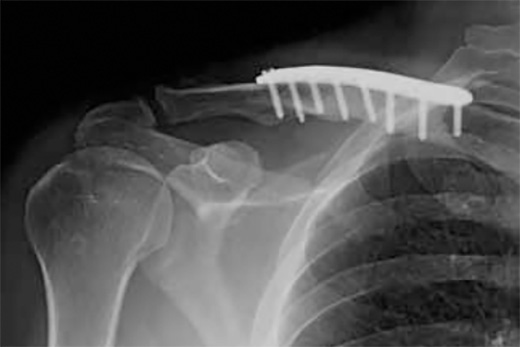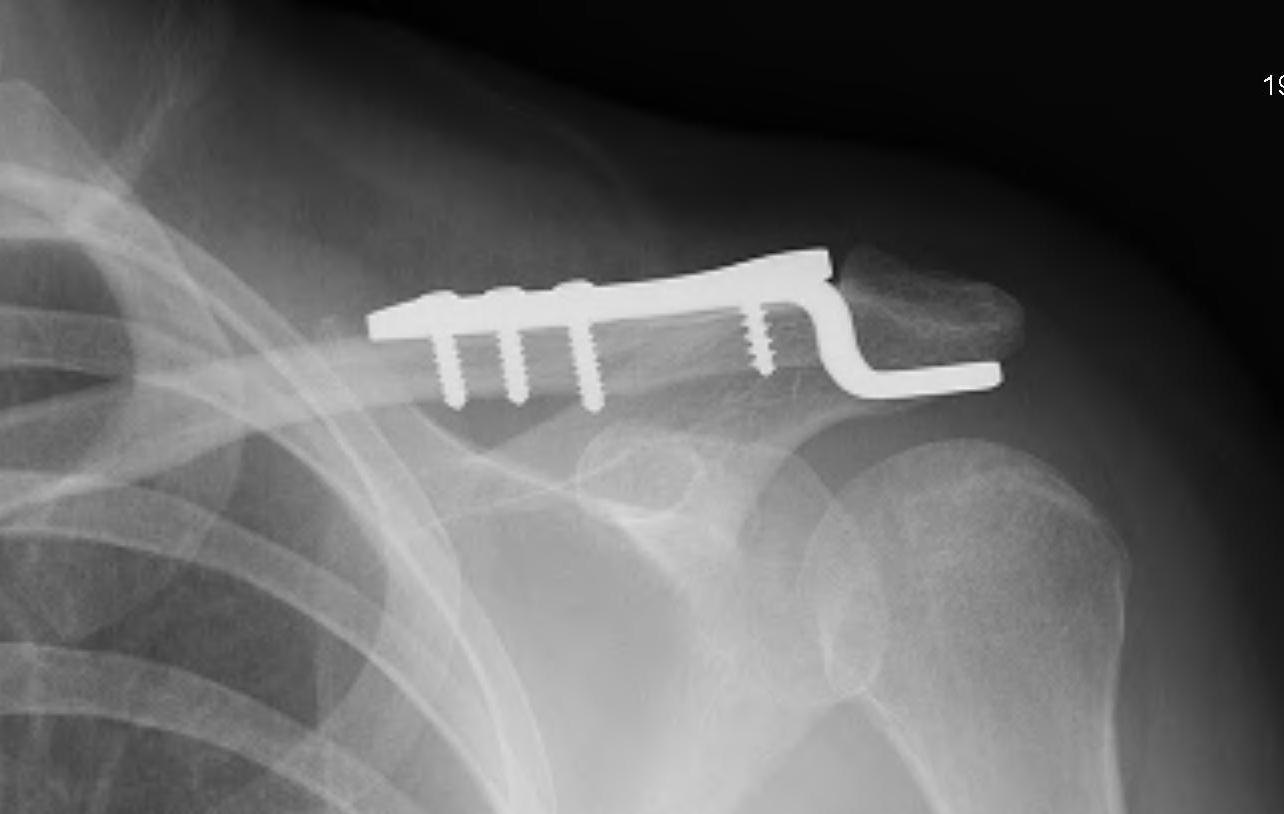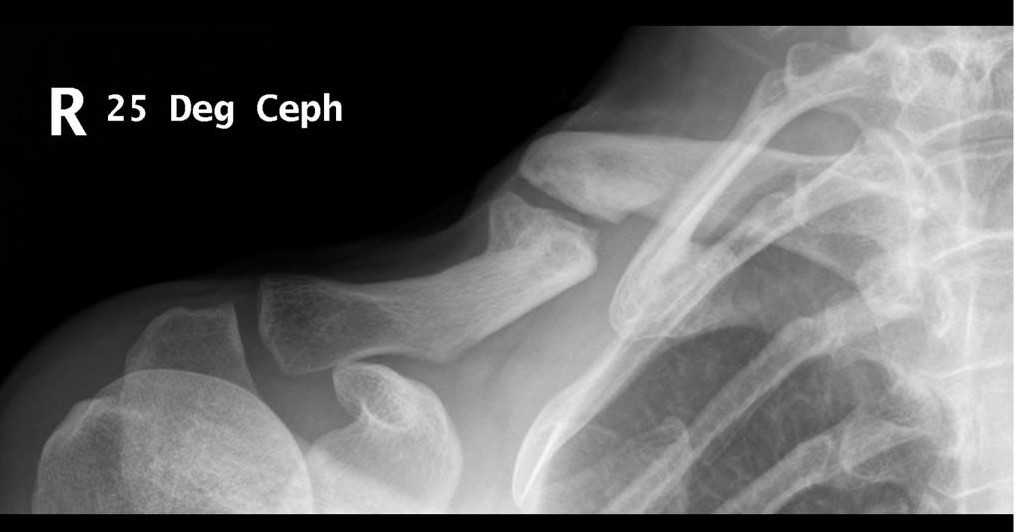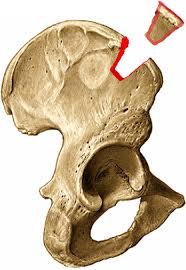Clavicle fracturesA broken collarbone, or fractured clavicle, is a common injury. The collarbone is a long, slender, S-shaped bone that runs from the breastbone (sternum) to each shoulder. The collarbone is the strut of bone that the whole shoulder joint hangs off. There is no bony connection of the shoulder joint at the back; the shoulder-blade is just embedded in muscle. So, when the collarbone fractures, displacement is common. However, on the plus side, the bone can also tolerate quite a lot of displacement and can still heal without the intervention of a surgeon.
The management of clavicle fractures is an area of great controversy between surgeons across the globe. It is frequently the topic of discussions at meetings between surgeons and commonly no resolution or agreement is found after days of presentations. There are a few agreed, absolute indications for surgery. These are open fractures (where the bone pokes through the skin), where there are symptoms of nerve damage and where there is also a fracture of the scapula neck (a so called ‘floating shoulder’).
Initial managementThe Emergency Department will do an X-ray and furnish you with a sling, usually a blue sling called a ‘polysling’. This can be removed for washing and dressing but is better if it worn at night in bed. It is a painful injury, certainly during the first 2 weeks. You should take some painkillers to settle the pain. Some swelling and bruising is normal and does settle in time. Pins and needles down the arm is not normal and this should be highlighted to a medical professional. You will be given an appointment for a fracture clinic.
Non-operative treatmentThis means that no surgery needs to take place. You should wear the sling for about 4 weeks. It can be removed for washing and dressing and for some gentle exercises particularly of the elbow, to stop it getting too stiff. It is not dangerous to remove the sling but remember the sling is for pain relief. At 4 weeks you should start to move the arm out of the sling for day-to-day purposes. Initially move the arm up to the level of the shoulder. At about 6 weeks you should start to try and lift the arm above the shoulder. Full recovery probably takes about 2 to 3 months. The advantage of nonoperative treatment is that you are not exposed to the risks of surgery, albeit, these are small. There is no scar if you don’t have surgery. There may be a lump over your clavicle at the fracture site. The size of this depends on your fracture pattern. The lump will remain after the healing process is complete. Fortunately the lump is not usually a problem and wearing of rucksacks etc on the shoulder is perfectly feasible.
Operative treatmentThe commonest way of fixing clavicle fractures is with a plate. The plate design and size will be selected according to your fracture pattern but they are usually about 1cm wide and 15cm long and made of titanium. They are low-profile which means they are engineered to be thin so they sit well beneath the skin. However sometimes they can still be felt under the skin and can cause irritation. The only clear advantage of fixing the fracture with a plate in the literature (medical research), is that people tend to return to physical work and sport earlier than those who have not had surgery. The other perceived advantages are better aesthetics (although you are exchanging a lump for a scar), quicker healing of the fracture, less pain and a lower chance of progressing to a non-union (the bone just not knitting together). I say ‘perceived’ and that is because no one has ever proven that these are actually true; we just think they could be considerations. These fractures are best fixed within 3 weeks of injury but there are many factors which may affect when your surgery can take place. You will normally come into hospital on the day of surgery and it is common to be discharged the same day as your surgery. You will need a general anaesthetic and usually some local anaesthetic will be put into the wound at the end of the surgery to help with the pain relief. The cut in the skin is made along the line of the clavicle. The two ends of the bone are cleaned up and put together and held in place with the plate and screws. The skin is closed with stitches and a dressing covers the wound. You will be given a navy-blue polysling afterwards. Unfortunately, as with all surgery, there is the risk of complications. These include infection, stiffness of surrounding joints, nerve injury, bleeding and non-union (the bone not healing). Fortunately these risks are small. Of course, if they happen to you then they are significant. It is common to have a small patch (5-6cm square) of numbness just beneath the scar after the surgery. This is due to the unavoidable cutting of the very tiny nerves in the skin. These nerves do re-grow so the patch will get smaller and smaller with time. The sling is usually recommended for 4 weeks to rest the arm and allow the fracture to start healing. It is not dangerous to remove the sling but it should be for short, controlled periods. You can take it off to get washed and dressed and do some gentle exercises, particularly of the elbow, hand and wrist. For the first 2 weeks, when you shower you should remove your sling but keep your arm by your side and forearm across your abdomen, like it were in the sling. Hold the shower-head in your other hand and shower low-down, away from your operated clavicle. Do not use your operated arm. Use a wet flannel around the dressing and under your arm. You must keep your dressing dry. After 2 weeks, when the wound has been checked and the stitches removed, you don’t need to keep the wound dry and you can shower normally. People usually return to driving at about 6 weeks post-op. Desk-based work is usually feasible from as early as a week after surgery, although perhaps not normal output. Manual work is usually possible at 6-8 weeks but you may need to wait until 3 months if you engage in very physical work, overhead activity or working in dangerous situations. You will be seen in the outpatient clinic for as long as it takes to confirm the fracture has healed and your symptoms have settled. Serial X-rays may be taken. 
Distal end clavicle fracturesThese are slightly different injuries to the midshaft clavicle fractures described above. Put simply, most midshaft fractures (above) will heal if managed without surgery. The opposite is true (almost) of distal end fractures. The distal end is the end of the bone furthest away from your head. The blood supply in this area is poor and so the fracture has a reasonable chance of not healing. In order to heal these injuries along, it may be recommended that you have a plate fixation early after your injury. Often the bone fractures close to the acromioclavicular joint and this makes them difficult to fix because there isn’t much bone left to get hold of with a screw (to use with a plate). Sometimes there is such little bone at the end that it is impossible to get enough screws in to achieve adequate fixation (hold) on the fragment. In this situation a hook-plate may be used. This is a plate with a ‘step’ in it (see image). The end of the plate, or the hook, goes under the acromion to prevent the clavicle lifting up which it tend to want to do due to the pull of the muscles and damaged ligaments that normally hold it down. The trouble is that hook sits in the subacromial space which is a tight spot anyway and so patients can’t usually tolerate a piece of metal sitting in there for very long. Therefore the plate usually needs to be removed at around 6 months. Unfortunately, this would involve an anaesthetic again and the wound opening-up but a sling wouldn’t need to be worn for more than a day or so after the surgery. After plate removal, the shoulder is usually a little stiff but close to normal shoulder function should resume over a few months, with good physio.  
Surgery for non-unionWhether you have early plate fixation or not of your clavicle fracture, you are still at risk of the bone not healing (non-union). If this occurs it may be obvious or you may require a CT scan to determine the level of healing that has taken place. A non-union wouldn’t normally be declared until about 3-6 months after the original injury. Once established you may be offered surgery (or further surgery if you already have a plate), to help the bone to heal. Usually this involves a general anaesthetic and the skin opening over the collarbone. The cells that have gathered around the two ends of the bone are cleared away and the ends of the bone are ‘freshened-up’. Good, bleeding bone ends makes for a healthy environment for the healing process to take place. You are likely to have bone-grafting performed also. Usually a small cut (5 or 6 cm) is made just over the brim of the pelvis (on same side as your injury), just where a belt would sit. The pelvis here is about one centimetre thick at the top. A small trap-door is made in the pelvic-wall and some of the soft bone cells (cancellous bone) is scraped out. I usually take a bit less than would fit on a teaspoon. Those bone cells are transferred up to the clavicle and these healthy cells can stimulate the healing process in the clavicle. Taking bone from your pelvis is not detrimental to that area. You can walk straight afterwards and the wound usually heals well. It can be quite painful (more painful than the clavicle surgery !). The bone cells regrow in that area very well.  
|